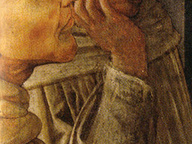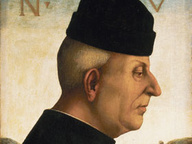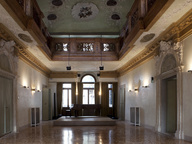This portrait of Sigismondo Malatesta, Lord of Rimini (1417-1468) is based on the official image of the prince as found on the Pisanello medals of 1445. It is interesting to compare this painting with Piero's 1451 fresco in the Tempio Malatesta in Rimini, showing the condottiere in profile, kneeling before the Burgundian king Sigismund, his patron saint. It has been conjectured, although there is no actual evidence, that this portrait was a preliminary to the larger composition.
Sigismondo Malatesta (1417-1468), Lord of Rimini, was a condottiere and captain of the church. His pride in his military successes drew the jealousy of Pope Pius II, who excommunicated him in 1460, and his subsequent struggles with the papacy earned this protector of the arts a reputation for cruelty and paganism. Sigismondo grew up in a cultivated family with links to the humanist court of Ferrara: there the House of Este gave him his first wife, Ginevra (1419-1440). Summoning the greatest artists of the period, he turned Rimini into a major Renaissance center: Alberti (1404-1472) designed the facade of the church of San Francesco in Rimini, where the Malatestas were buried and whose paganistic interior earned it the nickname Tempio Malatestiano ("the Malatesta temple"). It was in this church, in 1451, that Piero della Francesca painted a fresco showing Sigismondo in profile, kneeling before his patron saint. The similarities between the fresco and the Louvre portrait suggest that the latter was painted before 1451 and used as a model for the mural.
This head and shoulders profile of a richly dressed subject is an example of the court portrait, much esteemed in the art circles of northern Italy when the "International Gothic" was in full flower. It draws on the images for coins that came in the wake of humanist interest in Classical antiquity. Unlike the delicately worked faces produced by Pisanello, however, this one stands out in vigorous relief from its dark background. When in Florence in 1439, Piero was doubtless marked by painterly experiments in the representation of space and volume. Thus, in contrast with Pisanello's Portrait of a Princess of the House of Este in the Louvre, the subject's shoulder, shown in full profile, seems foreshortened in terms of standard visual perspective. The play of light gives a powerfully modeled, column-like neck. The artist tends to geometrize the forms, as in the way the line of the hair hews to the diagonal of the picture, dividing the composition in two.
In this work Piero enriches his knowledge of Florentine painting with a meditation on Flemish art: the court of Ferrara, where he stayed around 1448-50, offered a number of examples, notably a triptych by Roger Van der Weyden (1399/1400-1464). Analysis of the paint has shown that in some places Piero had added oil to the egg that was the standard binder at the time. Only the greater suppleness of oil allowed him to achieve the perfection of skin tone we find here: subtlety of contour, transparency - the skin beneath the bluish shading of the shaven cheek - and the precision of such touches as the thread of light beneath the chin. It was this Flemish-inspired use of the medium that allowed Piero to create here what seems to be a living portrait.
COMMENTI
LE OPERE
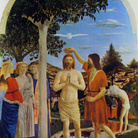 Il Battesimo di Cristo
1450 | Tempera su tavola | 116 x 167 cm.
Il Battesimo di Cristo
1450 | Tempera su tavola | 116 x 167 cm.
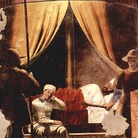 Il sonno di Costantino
Affresco
Il sonno di Costantino
Affresco
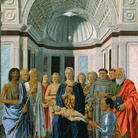 Pala di Brera o Pala Montefeltro
Tempera su tavola
Pala di Brera o Pala Montefeltro
Tempera su tavola
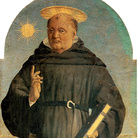 San Nicola da Tolentino
1454 | Tecnica mista
San Nicola da Tolentino
1454 | Tecnica mista
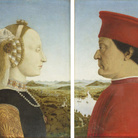 Ritratto dei Duchi di Urbino
1465 | Olio su tavola | 47 x 33 cm.
Ritratto dei Duchi di Urbino
1465 | Olio su tavola | 47 x 33 cm.
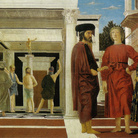 Flagellazione di Cristo
1460 | Tempera su tavola | 58 x 81 cm.
Flagellazione di Cristo
1460 | Tempera su tavola | 58 x 81 cm.
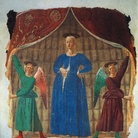 Madonna del Parto
1455 | Affreschi | 260 x 203 cm.
Madonna del Parto
1455 | Affreschi | 260 x 203 cm.
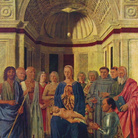 La Vergine con il Bambino e i Santi
1469 | Tecnica mista | 170 x 248 cm.
La Vergine con il Bambino e i Santi
1469 | Tecnica mista | 170 x 248 cm.
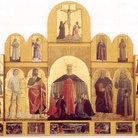 Polittico della Madonna della Misericordia
1445 | Olio su tavola | 330 x 273 cm.
Polittico della Madonna della Misericordia
1445 | Olio su tavola | 330 x 273 cm.
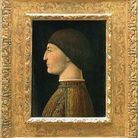 Ritratto di Sigismondo Pandolfo Malatesta
1451 | Tecnica mista | 34 x 44 cm.
Ritratto di Sigismondo Pandolfo Malatesta
1451 | Tecnica mista | 34 x 44 cm.
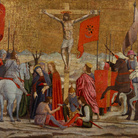 La Crocifissione
1454 | Tempera su tavola | 41 x 37 cm.
La Crocifissione
1454 | Tempera su tavola | 41 x 37 cm.
Map
Works in Italy
Works around the world
